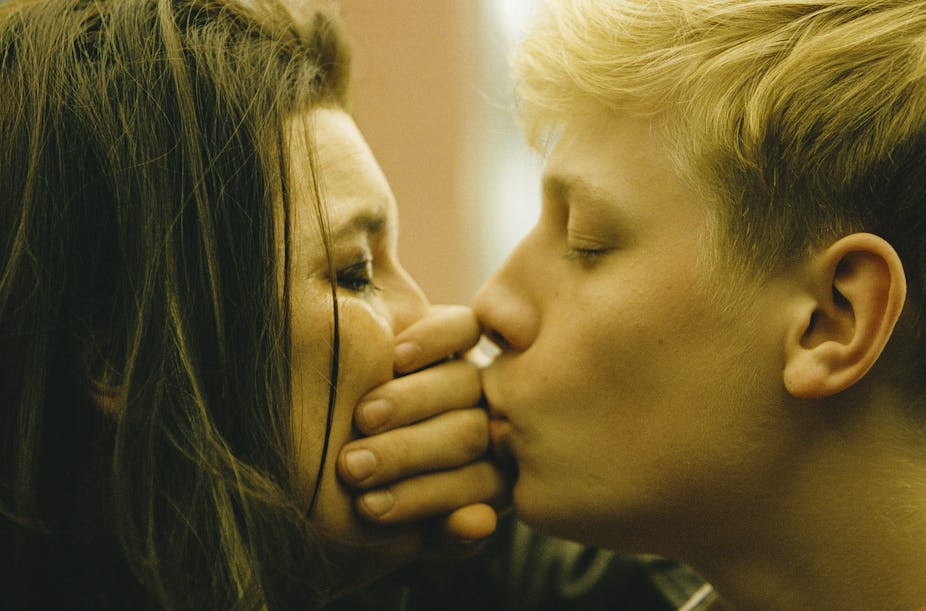Images as tall as, or taller than, they are wide are unusual in cinema. Landscape is very much the given. But, as Miriam Ross has recently pointed out, vertically framed video is becoming more and more commonplace in another sphere – amateur films made using handheld devices. The technique suggests “liveness” and a sort of documentary realism, since the filmmaker just whips out their phone and records events without having time to frame things otherwise.
Mommy, the new film by Québecois wunderkind Xavier Dolan, is mainly shot in a square 1:1 aspect ratio, giving it that amateur feel that, in the contemporary era, somehow seems as if it doesn’t belong in the cinema (even if time was that aspect ratios close to square were common, e.g. in the late 1920s). While the three lead performances – Anne Dorval as Diane “Die” Després, Antoine-Olivier Pilon as her son Steve and Suzanne Clément as their neighbour Kyla – are all infused with an emotional intensity that we might deem realistic, the framing does not here suggest documentary realism.
Rather, Dolan’s movie is evidently staged. The lighting scheme makes this clear, especially the use of yellows for domestic scenes, together with the slow motion sequences, musical montages and the like. So Mommy is not an “authentic” phone film, but phones do feature, and it does comment on the mobile phone generation.

A fictional 2015
Steve is an ADHD-suffering youth who cannot concentrate on anything, nor control his tongue or actions, as demonstrated by his violent outbursts.
The film opens with Steve being sent home from a detention centre after throwing coffee in a young man’s face. He quickly loses his mum her job by abusing a co-worker, gets into a fight with a black taxi driver, and then has a violent confrontation with Die when he refuses to take a chill pill.
This is when Steve meets Kyla, who stitches up a cut on his leg. Kyla is a school teacher on sabbatical and who stutters as a result of an unspoken trauma. The three become friends, of sorts.
But things get worse, and the pressure is on the Després family to stay afloat. Steve’s ongoing erratic behaviour prompts Die to contemplate having him sectioned in accordance with a new (fictional) law explained at the film’s outset. That Dolan sets Mommy in a fictional 2015 that features this law of parental abandonment lends the film an allegorical aspect, suggesting that it as much about 2015’s mobile phone generation as about these three particular characters.

Cinematic dream
As mentioned, mobile phones do feature: a kid starts filming Steve at a particularly horrible moment, while Mommy also features several important missed calls. Steve also pointedly takes a selfie of Die, Kyla and himself one evening.
Dolan is too intelligent a director to assert that phones are specifically causing Steve’s behaviour, but the square framing suggests a sense of limited vision in a world where technology is ubiquitous. Kyla’s dysfunctional home life seems related to her programmer husband’s commitment to his computer, while Die’s dead husband, Richard, invented a kind of microwave (the Heater-Waver) before dying of cancer. Technology, it seems, disconnects rather than connects us, narrowing our world rather than expanding it.
After Steve takes the selfie, the image is printed in horizontal, rather than square, framing. Is there hope, then, that technology can unite people? This sense of hope is twice reaffirmed when Mommy breaks from its restrictive framing and expands into the more conventionally “cinematic” widescreen framing.
The first is when Steve, Die and Kyla ride around town on their respective longboard and bikes, Steve joyfully tossing food at cars behind him as he pushes a shopping trolley home. And the second is when Die drives Steve on a trip to the country.
So travel, it would seem, broadens the mind – and yet these moments of feeling “cinematic”, as represented by the widescreen, are short-lived and illusory. “Cinema” (widescreen) might be the stuff of dreams, especially as we briefly see in the second widescreen section a projected alternative future in which Steve gets into Juilliard, marries and has kids. But cinema is quickly replaced by the technologised reality of square framing, in which humans are hemmed in by the aspect ratio – as Die and Steve are hemmed in by financial concerns (and have no time for movies, only mobile phones).
Crucially, Steve is not all trouble but also a charming performer. We like him. A singalong to Céline Dion wearing make-up and nail varnish suggests that he may be a home movie legend in the making – with the square framing suggesting his comfort in enclosed, domestic spaces. Put in public in a karaoke bar, however, and Steve clams up, his small-screen humour the cause of jeers in the bigger, badder world.
In other words, the film is not simply a critique of the mobile phone generation. It is a critique of the technologised world. Vertical framing is also known as portrait framing, and Mommy provides a fascinating portrait of three engaging and troubled characters who struggle to break free from this world, with limited release.
In our mobile phone era, it may be increasingly hard for people to concentrate given the constant distractions of technology. But Mommy is a film in which it is worth investing as much of one’s attention as possible. It might help us not just briefly to escape our own hemmed-in existence, but it might also give us the courage to change it.

